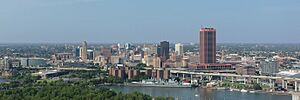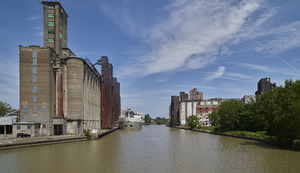Economy of Buffalo, New York facts for kids
The economy of Buffalo and its surrounding area is a mix of different types of businesses. It includes factories that make things, companies that use advanced technology, and businesses that provide services. Instead of relying on just one type of industry, Buffalo has chosen to have many different kinds of businesses. This helps create lots of chances for the area to grow and succeed in the future.
Contents
Buffalo's Economic Journey
For a long time, Buffalo was a very busy place for trains, making steel, building automobiles, designing airplanes, and shipping goods on the Great Lakes. It was also a huge storage area for grain. Over the years, many of these big industries left the city. For example, most of the large steel factories are gone, though some smaller ones still operate. Back in the 1950s, Buffalo was one of the biggest cities in the U.S. It was known as a major port, a huge train hub, a top steel producer, and a big manufacturing center.
How Jobs Have Changed
As Buffalo's population changed and many factories closed, the types of jobs available also shifted. In the past, many people worked in manufacturing. Now, more jobs are in other areas. For instance, there has been a big increase in jobs related to education and health services. Also, many new jobs have appeared in professional and business fields, especially in finance. This shows that Buffalo's job market is becoming more diverse.
Cool Science and Health Innovations
Buffalo is becoming a major hub for bioinformatics and human genome research. This means scientists are using computers to study biology and understand our DNA. Important work is happening at places like the University at Buffalo and the Roswell Park Comprehensive Cancer Center. These and other health organizations work together in a special area called the Buffalo Niagara Medical Campus.
This campus is home to many groups that focus on health and science. They include places for hearing and speech, medical research, and even a center for people with vision problems. There are also companies that help new science businesses grow. For example, one company helped launch Empire Genomics, which uses research from Roswell Park to create personalized medicine. This means treatments can be made just for you, based on your unique DNA!
Banks and Financial Services
Buffalo is home to M&T Bank, a very large regional bank. Another big bank, Marine Midland Bank, used to operate from downtown Buffalo before it was bought by HSBC. While HSBC has reduced its presence, other major banks like Bank of America and KeyBank also have offices in Buffalo. KeyBank even grew its operations after buying another local bank, First Niagara. Citigroup also has offices nearby. Buffalo has also become a center for companies that help collect debts.
First Niagara Bank, which used to be based near Buffalo, moved its main office to downtown Buffalo. It grew quite a bit, even buying many branches from HSBC in Western New York. This helped create more jobs in the Buffalo area. However, First Niagara was later bought by KeyBank.
Other Important Businesses

Buffalo is home to Rich Products, which is one of the world's biggest family-owned food companies. The Canadian beer company Labatt also has its U.S. headquarters in Buffalo. This is partly because Buffalo is located right in the middle of a major trade route between the U.S. and Canada. More than 80% of all trade between the two countries happens through border crossings in the eastern U.S., and Buffalo is a key spot with five bridges to Canada.
Other big names in Buffalo include Sorrento Lactalis, a cheese company, and General Mills, which has a cereal factory. Tops Friendly Markets, a regional grocery store chain, is also headquartered nearby. Delaware North, a company involved in food service and hospitality, also has its main office in Buffalo. Even Milk Bone dog biscuits are still made in a factory on the city's East Side!
New Era Cap Company, which makes sports hats, is also based in Buffalo. They opened their new main office in a historic building downtown.
While some older industries have moved, new ones are growing. For example, Tesla has a large factory in Buffalo called Gigafactory 2. It makes solar panels and is one of the biggest facilities of its kind in the Western Hemisphere. This factory opened in 2017 and is a big part of Buffalo's new economy.
Buffalo also has a program called 43 North. It's a competition that gives money to new startup companies. Winners get millions of dollars, help from mentors, office space, and tax benefits. This helps bring new and exciting businesses to the area.
Life in Buffalo: Affordability and Improvements
Buffalo has faced challenges as many traditional factory jobs left. However, the city is known for having a very affordable housing market. This means it's easier for families to buy homes here compared to many other U.S. cities. In fact, nearly 90% of homes sold in the Buffalo area are affordable for families earning the average income for the region.
The city has been working hard to improve itself. It has torn down many empty houses to make neighborhoods better. Also, as Buffalo has moved away from heavy industry and towards service and technology jobs, the air and water quality have improved. This is good for everyone living in and visiting the city. In 2005, Reader's Digest even called Buffalo one of the cleanest large cities in the nation!
Buffalo's economy has really started to get better since the early 2010s. With money from the state government and plans for new construction projects, hundreds of new jobs have been created, bringing positive changes to the area.
Who Employs the Most People?
Here are some of the biggest employers in the Buffalo area:
| # | Employer | # of Employees |
|---|---|---|
| 1 | State of New York | 23,600 |
| 2 | Federal Executive Board (United States of America) | 15,000 |
| 3 | Kaleida Health | 8,301 |
| 4 | M&T Bank | 7,400 |
| 5 | Catholic Health | 7,184 |
| 6 | University at Buffalo | 7,076 |
| 7 | Buffalo City School District | 6,528 |
| 8 | Tops Markets | 5,374 |
| 9 | Erie County | 5,010 |
| 10 | Erie County Medical Center | 3,450 |
Other Important Companies in the Buffalo Area
Many other notable companies have major operations or headquarters in Buffalo or the surrounding area. This list shows how diverse the local economy is:
|
|




